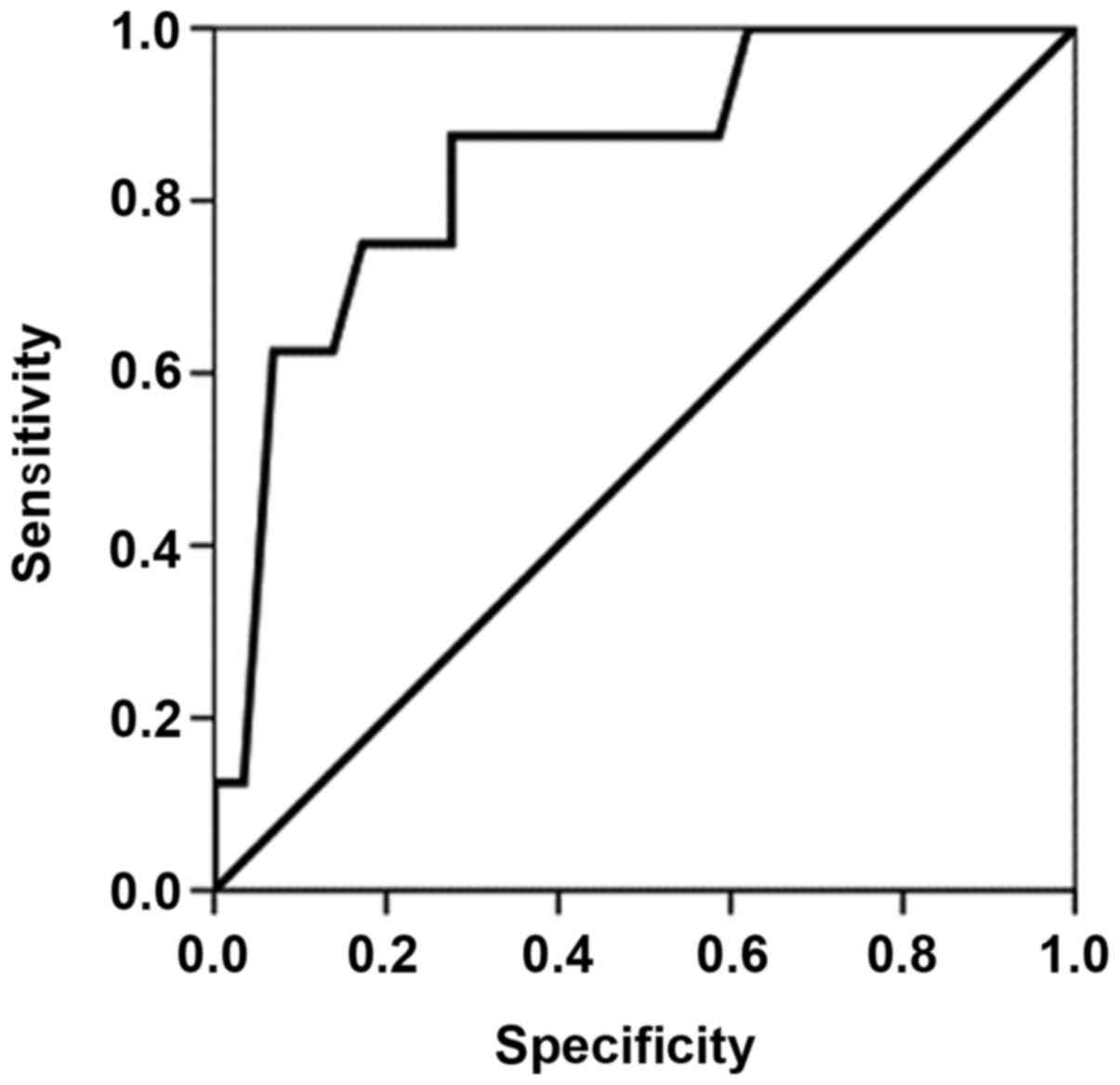|
1
|
García-Garmendia JL, Ortiz-Leyba C,
Garnacho-Montero J, Jiménez-Jiménez FJ, Pérez-Paredes C,
Barrero-Almodóvar AE and Gili-Miner M: Risk factors for
Acinetobacter baumannii nosocomial bacteremia in critically ill
patients: A cohort study. Clin Infect Dis. 33:939–946. 2001.
View Article : Google Scholar : PubMed/NCBI
|
|
2
|
Jaggi N, Sissodia P and Sharma L: Control
of multidrug resistant bacteria in a tertiary care hospital in
India. Antimicrob Resist Infect Control. 1:232012. View Article : Google Scholar : PubMed/NCBI
|
|
3
|
Falagas ME and Rafailidis PI: Attributable
mortality of Acinetobacter baumannii: No longer a controversial
issue. Crit Care. 11:1342007. View
Article : Google Scholar : PubMed/NCBI
|
|
4
|
Lemos EV, de la Hoz FP, Einarson TR,
McGhan WF, Quevedo E and Castañeda C and Kawai K: Carbapenem
resistance and mortality in patients with Acinetobacter baumannii
infection: Systematic review and meta-analysis. Clin Microbiol
Infect. 20:416–423. 2014. View Article : Google Scholar : PubMed/NCBI
|
|
5
|
Grupper M, Sprecher H, Mashiach T and
Finkelstein R: Attributable mortality of nosocomial Acinetobacter
bacteremia. Infect Control Hosp Epidemiol. 28:293–298. 2007.
View Article : Google Scholar : PubMed/NCBI
|
|
6
|
Aydemir H, Celebi G, Piskin N, Oztoprak N,
Keskin AS, Aktas E, Sumbuloglu V and Akduman D: Mortality
attributable to carbapenem-resistant nosocomial Acinetobacter
baumannii infections in a Turkish university hospital. Jpn J Infect
Dis. 65:66–71. 2012.PubMed/NCBI
|
|
7
|
Maragakis LL, Cosgrove SE, Song X, Kim D,
Rosenbaum P, Ciesla N, Srinivasan A, Ross T, Carroll K and Perl TM:
An outbreak of multidrug-resistant Acinetobacter baumannii
associated with pulsatile lavage wound treatment. JAMA.
292:3006–3011. 2004. View Article : Google Scholar : PubMed/NCBI
|
|
8
|
Wang H, Zhao CJ, Wang ZW, Ni YX, Chen MJ,
Xu YC, Yu YS, Zhang LY, Mei YN, Chu YZ, et al: Report from Chinese
Meropenem Susceptibility Surveillance in 2010 Antimicrobial
resistance among nosocomial Gram negative bacilli. Zhong Hua Jian
Yan Yi Xue Za Zhi. 34:897–904. 2011.(In Chinese).
|
|
9
|
Falagas ME and Rafailidis PI: Attributable
mortality of Acinetobacter baumannii: No longer a controversial
issue. Crit Care. 11:1342007. View
Article : Google Scholar : PubMed/NCBI
|
|
10
|
Shi Y, Xu YC, Liu Y, Du W, Rui X and Wang
Y: Cefoperazone-sulbactam plus minocycline in the treatment of
extentively drug resistant Acinetobacter infections. Zhong Hua Yi
Xue Za Zhi. 92:2847–2850. 2012.(In Chinese).
|
|
11
|
Yu Z, Zhang D, Yan JJ and Zhou QS:
Acinetobacter baumannii infection in intensive care unit: A
retrospective analysis. Wu Han Da Xue Xue Bao (Yi Xue Ban).
34:895–898. 2013.(In Chinese).
|
|
12
|
Chen B, He LX, Hu B, Ni YX, Qiu H, Shi Y,
Shi Y, Wang H, Wang M, Yang Y, et al: Expert Consensus Document on
Acinetobacter baumannii infection diagnosis, treatment and
prevention in China. Zhong Hua Yi Xue Za Zhi. 92:76–85. 2012.(In
Chinese).
|
|
13
|
Knaus WA, Draper EA, Wagner DP and
Zimmerman JE: APACHE II: A severity of disease classification
system. Crit Care Med. 13:818–829. 1985. View Article : Google Scholar : PubMed/NCBI
|
|
14
|
Vincent JL, Moreno R, Takala J, Willatts
S, De M, endonça A, Bruining H, Reinhart CK, Suter PM and Thijs LG:
The SOFA (Sepsis-related organ failure assessment) score to
describe organ dysfunction/failure. On behalf of the working group
on sepsis-related problems of the European society of intensive
care medicine. Intensive Care Med. 22:707–710. 1996. View Article : Google Scholar : PubMed/NCBI
|
|
15
|
Xing XZ, Wang HJ, Huang CL, Yang QH, Qu
SN, Zhang H, Wang H, Gao Y, Xiao QL and Sun KL: Prognosis of
patients with shock receiving vasopressors. World J Emerg Med.
4:59–62. 2013. View Article : Google Scholar : PubMed/NCBI
|
|
16
|
Levy MM, Fink MP, Marshall JC, Abraham E,
Angus D, Cook D, Cohen J, Opal SM, Vincent JL and Ramsay G:
SCCM/ESICM/ACCP/ATS/SIS: 2001 SCCM/ESICM/ACCP/ ATS/SIS
International Sepsis Definitions Conference. Crit Care Med.
31:1250–1256. 2003. View Article : Google Scholar : PubMed/NCBI
|
|
17
|
Wang L, Shi XH and Xiao D: Drug resistance
of Acinetobacter baumannii infection in SICU. Xinjiang Medicine.
43:141–142. 2013.
|
|
18
|
Qiao L, Zhang JS, Mei YN, Zhang HZ and Su
CL: Analysis of risk factors for the prognosis of Acinetobacter
baumannii bloodstream infection. Zhonghua Wei Zhong Bing Ji Jiu Yi
Xue. 25:471–474. 2013.(In Chinese). PubMed/NCBI
|
|
19
|
Park YK, Jung SI, Park KH, Kim DH, Choi
JY, Kim SH and Ko KS: Changes in antimicrobial susceptibility and
major clones of Acinetobacter calcoaceticus-baumannii complex
isolates from a single hospital in Korea over 7 years. J Med
Microbiol. 61:71–79. 2012. View Article : Google Scholar : PubMed/NCBI
|
|
20
|
Wang H, Liu D, Chen P, Wang Z and Cheng Y:
A survey of risk factors of Acinetobacter baumannii infection in
trauma patients and their mortality. Chong Qing Yi Xue.
40:3665–3667. 2011.(In Chinese).
|
|
21
|
Ma MY, Xu J, Yu N and Huang GM: Analysis
of drug resistance of Acinetobacter baumannii and its related
factors in ICU. Zhonghua Wei Zhong Bing Ji Jiu Yi Xue. 25:686–689.
2013.(In Chinese). PubMed/NCBI
|
|
22
|
Bacakoğlu F, Ekren P Korkmaz, Taşbakan MS,
Başarik B, Pullukçu H, Aydemir S, Gürgün A and Başoğlu OK:
Multidrug-resistant Acinetobacter baumannii infection in
respiratory intensive care unit. Mikrobiyol Bul. 43:575–55.
2009.(In Turkish). PubMed/NCBI
|















